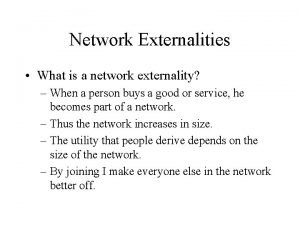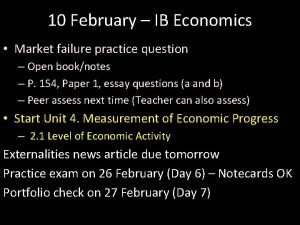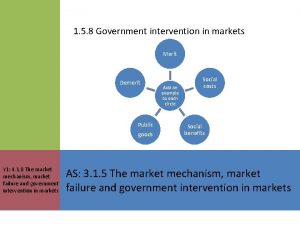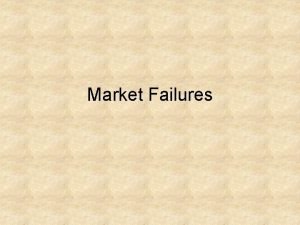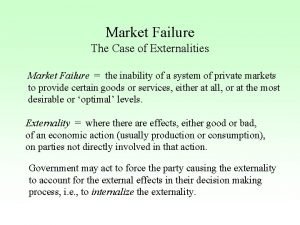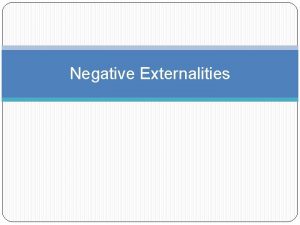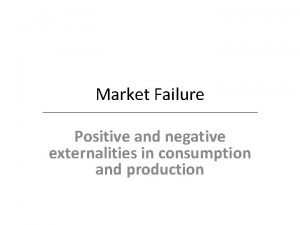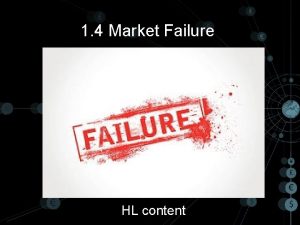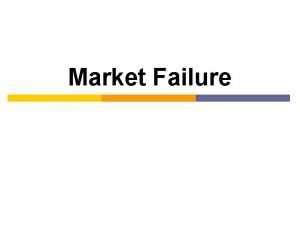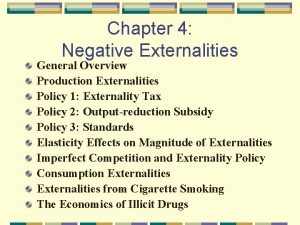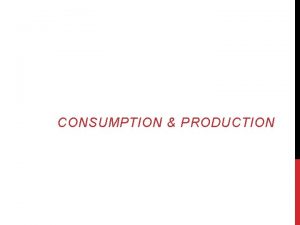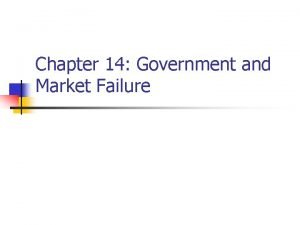Market Failure Content Externalities in Production and Consumption






















- Slides: 22

Market Failure

Content • Externalities in Production and Consumption: – Positive – Negative • • • Public goods Merit goods Demerit goods Market imperfections Inequalities in: – Wealth distribution – Income distribution

Externalities • Externalities result from differences between private and social costs or benefits • Externalities can be positive or negative: – Positive – these have beneficial effects on 3 rd parties – Negative – these are costs that incurred by 3 rd parties

External Costs / Negative externalities • External costs created by businesses can impact the environment in the following ways: • Urban blight – excessive development and inappropriate developments mean the environment is visually less attractive, loss of farmland • Production and disposal of waste – this could include an increase in litter and rubbish from packaging • Use of energy • Pollution: – – – Noise – from cars, lorries, factories etc Air – emissions from cars and delivery vehicles Land Sea Water

Negative externalities • If you consider private costs then they would supply along supply curve S • Negative externalities mean that social costs are higher so the new supply curve should be S 1 and equilibrium moved to P 1

External Benefits / Positive externalities • As well as external costs businesses can create external benefits • External benefits are advantages a business brings to the local community when it locates its business in a particular area. These benefits will be positive for the local community. • Examples: • Employment • Quality of life • Providing a service • Regeneration of land

External Benefits / Positive Externalities • If the business was supplying products ignoring social benefits the initial supply curve S 1

External Costs and benefits In production • External costs are where MSC = MSB – MPC e. g. pollution, traffic congestion • External benefits are where MSC < MPC e. g. research and development in industry, human resource development

External costs and benefits in consumption • External costs = where MSB < MPB e. g. anti-social behaviour, passive smoking, noise • External benefits = where MSB > MPB e. g. public transport, vaccinations, attractive surroundings

Externalities • The presence of negative externalities is likely to cause over production of a product • The presence of positive externalities is likely to lead to under production of a product • Externalities can lead to market failure if the pricing mechanism fails to account for the social costs and benefits of production

Value of Externalities • The value of social costs and benefits can be measured by looking at: – Consumer surplus – Producer surplus – Cost-benefit analysis : what is the balance of costs and benefits – Willingness to pay

Cost Benefit Analysis • Identify all costs and benefits • Measure the value of all costs and benefits • Calculate the likelihood of costs and benefits • Analyse the timing of the costs and benefits looking at present value • Decide whether the project is worth undertaking

Public Goods • These are services that are provided by the government • Pure public goods have the following characteristics: – Non excludability – everyone can consume the goods whether they pay or not – Non rivalry in consumption – consumption by one person doesn’t reduce consumption for others • Examples – street lighting, national defence

Public goods and Market Failure • You cant get an individual to pay for public goods as others can get the benefits from consumption without paying • Private companies will not supply public goods as they don’t make an economic profit on them • Public goods are only supplied by the government and financed through taxation

Private goods • Private goods have the following characteristics: – Excludability – if you don’t pay you can be excluded from consuming the product – Rivalry – the consumption of one person reduces the amount available for others to consume – Rejectability – you can choose not to consume them and therefore reject them

Merit goods • Merit goods are where social benefits exceed social costs – they generate positive externalities • Governments aim to provide more of these goods due to the benefits to society • They may subsidise the production of such goods reducing the marginal costs of consumption and therefore increasing demand • Examples – healthcare, education

Merit goods and Market Failure • If the government didn’t step in and produce merit goods then they would be under produced • Attributable to the fact that individuals do not realise the benefits of consuming these goods

Demerit goods • Demerit goods are where social costs outweigh social benefits – they generate negative externalities • Governments try and reduce the consumption of these goods through higher taxes • Examples – cigarettes, alcohol

Market imperfections • Monopolies – these are often viewed as allocating resources inefficiently as the producer is able to charge higher prices due to being the only producer in the market • Imperfect knowledge of the market can also cause market failure

Immobility of factors of production • These can lead to market failure and may be due to: • Occupational immobility – this occurs when there are barriers of mobility between different jobs and different industries • Geographical immobility exists when there are barriers to people of moving to different locations

Inequalities • In market economies an individuals ability to consume goods and services is dependent on their income / wealth • An uneven distribution of income / wealth within an economy can result in an unsatisfactory allocation of resources and therefore market failure • In many developing countries income inequality is great therefore resulting in misallocation of resources

Summary • • • Externalities are caused when social benefits / costs are different to private benefits / costs Positive externalities occur where social benefits are greater than private benefits Negative externalities occur where social costs are greater than private costs Cost benefit analysis looks at the costs and benefits of producing / consuming a product Public goods are goods that are provided by the government e. g. street lighting Merit goods are where social benefits exceed social costs e. g. healthcare the government encourages people to use these Demerit goods are where social costs exceed social benefits e. g. smoking the government discourages people to use these through taxation Market imperfections can be caused by monopolies, imperfect market knowledge and factor immobility which can result in misallocation of resources Inequalities in wealth and income distribution may result in a misallocation of resources as the rich consume more
 Alur proses multimedia
Alur proses multimedia Market power market failure
Market power market failure Ethics of food production and consumption
Ethics of food production and consumption Failure to capture vs failure to sense ecg
Failure to capture vs failure to sense ecg Failure to sense vs failure to capture
Failure to sense vs failure to capture Brittle fracture vs ductile fracture
Brittle fracture vs ductile fracture Pure public good
Pure public good Externalities problems and solutions
Externalities problems and solutions What is a network externality?
What is a network externality? Externalities in environmental economics
Externalities in environmental economics Deadweight loss with positive externality
Deadweight loss with positive externality Network externalities
Network externalities Marketing segmentation targeting positioning
Marketing segmentation targeting positioning What is esp
What is esp Leader follower challenger nicher
Leader follower challenger nicher Dynamic content vs static content
Dynamic content vs static content Define market failures
Define market failures Role of government in correcting market failure
Role of government in correcting market failure Ib economics market failure questions
Ib economics market failure questions Indirect tax to correct market failure
Indirect tax to correct market failure Producer tax burden
Producer tax burden Market failure quiz
Market failure quiz Market failures
Market failures








